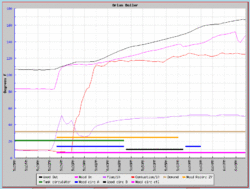Hello all-
It's becoming apparent to me that my remaining wood is, on whole, not as dry as I'd hoped... but it's what I've got ... and I am committed to buying no more oil. Lots of it is White Ash, which is reputed to be pretty decent to burn even when not all that well seasoned, and red pine, which is supposedly in the same category... but anyway, it is harder to get lit than the stuff I was using at the start of using my Econoburn 150.
Given that, I am finding that unless I get a fire going to the optimum point before I shut the updraft flap and kick on the downdraft fan, well... the whole thing kind of goes nowhere, unless I back up, kill the blower, open the updraft flap, get it raging again, then try again- which not only delays heat, but takes up a bunch of time with the fiddling around factor..
This is all with the NoFo "4 minutes to gasification" method- which seemed to indeed produce great light-offs with my original batch of maple and cherry cut during late April 08- it's just that now I am into other wood that really did not get processed until rather late in the season.
Anyone have any suggestions as to how to know/ judge whether and when there is enough of an "updraft burn" going to have confidence that it's time to switch to downdraft mode?
I have a stack thermometer, and a draft gauge (which holds mostly steady thanks to my barometric damper) and also watch the control readout on my Econoburn, but have yet to find the right objective/ intuitive way, at least with my not-so-dry wood, to know when to 'hit the afterburners' by turning on the fan and closing the damper for downdraft
Also, while I am at it, let me ask this, too- my Econoburn 150 does not have a continuously-variable fan, but, rather, has three modes: no fan, slow fan, and high fan. By changing the aimed-for temperature on the PLC controller, I can control whether the fan is in slow or high mode during the initial change from up-draft to down-draft. Any thoughts whether a mild wind or a wild wind is the best way to initiate and build momentum of gasification?
Thanks, as always, for all the knowledge around here and the willingness to share it
It's becoming apparent to me that my remaining wood is, on whole, not as dry as I'd hoped... but it's what I've got ... and I am committed to buying no more oil. Lots of it is White Ash, which is reputed to be pretty decent to burn even when not all that well seasoned, and red pine, which is supposedly in the same category... but anyway, it is harder to get lit than the stuff I was using at the start of using my Econoburn 150.
Given that, I am finding that unless I get a fire going to the optimum point before I shut the updraft flap and kick on the downdraft fan, well... the whole thing kind of goes nowhere, unless I back up, kill the blower, open the updraft flap, get it raging again, then try again- which not only delays heat, but takes up a bunch of time with the fiddling around factor..
This is all with the NoFo "4 minutes to gasification" method- which seemed to indeed produce great light-offs with my original batch of maple and cherry cut during late April 08- it's just that now I am into other wood that really did not get processed until rather late in the season.
Anyone have any suggestions as to how to know/ judge whether and when there is enough of an "updraft burn" going to have confidence that it's time to switch to downdraft mode?
I have a stack thermometer, and a draft gauge (which holds mostly steady thanks to my barometric damper) and also watch the control readout on my Econoburn, but have yet to find the right objective/ intuitive way, at least with my not-so-dry wood, to know when to 'hit the afterburners' by turning on the fan and closing the damper for downdraft
Also, while I am at it, let me ask this, too- my Econoburn 150 does not have a continuously-variable fan, but, rather, has three modes: no fan, slow fan, and high fan. By changing the aimed-for temperature on the PLC controller, I can control whether the fan is in slow or high mode during the initial change from up-draft to down-draft. Any thoughts whether a mild wind or a wild wind is the best way to initiate and build momentum of gasification?
Thanks, as always, for all the knowledge around here and the willingness to share it


